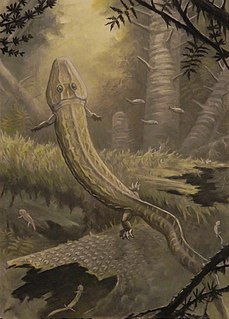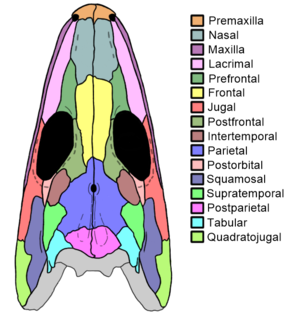 W
WAnthracosaurus is an extinct genus of embolomere, a possible distant relative of reptiles that lived during the Late Carboniferous in what is now Scotland and England. It was a large, aquatic eel-like predator able to grow up to 3 m (10 ft) in length. It has a robust skull about 40 centimetres (1.3 ft) in length with large teeth in the jaws and on the roof of the mouth. Anthracosaurus probably inhabited swamps, rivers and lakes. Its name is Greek for "coal lizard".
 W
WEldeceeon is an extinct genus of reptiliomorph from the Mississippian of Scotland. It is known from two fossil specimens found within the Viséan-age East Kirkton Quarry in West Lothian. The type and only species, E. rolfei, was named in 1994. Eldeceeon is thought to be closely related to embolomeres, but it has several distinguishing features including long limbs and a short trunk. Initially known from two crushed partial skeletons, additional specimens have been reported by Ruta & Clack (2006).
 W
WEogyrinus attheyi was one of the largest Carboniferous tetrapods, and perhaps one of the largest of its family, Eogyrinidae, at 4.6 metres (15 ft) in length.
 W
WPholiderpeton is an extinct genus of amphibian which lived in the Late Carboniferous period (Bashkirian) of Europe. Pholiderpeton was 2 m in size. Recent studies by Jennifer A. Clack suggest that the amphibian Pholiderpeton described by Thomas Henry Huxley in 1869 is the same animal as Eogyrinus. If this is so, then Pholiderpeton's name takes priority. Fossils of Eogyrinus are known from northern England.
 W
WProterogyrinus was an extinct genus of early tetrapods from the order Embolomeri. Fossil remains of Proterogyrinus have been found in Scotland, UK, and West Virginia, United States, and date back to the Serpukhovian, which is from about 331 to 323 million years ago. The genus was originally named by renowned vertebrate paleontologist Alfred Sherwood Romer in 1970. A comprehensive redescription was later published by Canadian paleontologist Robert Holmes in 1984. The generic name "Proterogyrinus" is Greek for "earlier wanderer" or "earlier tadpole". This name was chosen by Romer in keeping with a trend of naming long-bodied early tetrapods with the suffix "-gyrinus".
 W
WPteroplax is an extinct genus of embolomerous anthracosaur. Only one species has been described; the skull table noted is the lectotype of this species. Pteroplax dates from the late Carboniferous Period, about 315 million years ago. It is known with certainty only from Newsham in Blyth, Northumberland, England. At that site, it shared a coal-swamp lake habitat with the larger embolomere, "Eogyrinus". Pteroplax probably grew up to about 10 ft (3.0 m) in length and was largely aquatic, feeding upon fish and smaller tetrapods. It likely had a long, eel-like body, with short limbs and a long tail.
 W
WSolenodonsaurus is an extinct genus of reptiliomorphs that lived in what is now Czech Republic, during the Westphalian stage.